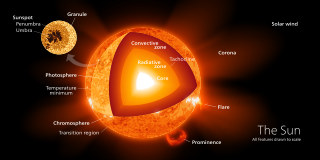
Back منطقة الإشعاع Arabic Зона прамяністага пераносу Byelorussian Zona de radiació Catalan Vrstva v zářivé rovnováze Czech Zona de radiación Spanish Päikese kiirgustsoon Estonian ناحیه تابشی Persian Zone radiative stellaire French Zona radiasi ID Zona radiativa Italian

A radiation zone, or radiative region is a layer of a star's interior where energy is primarily transported toward the exterior by means of radiative diffusion and thermal conduction, rather than by convection.[1] Energy travels through the radiation zone in the form of electromagnetic radiation as photons.
Matter in a radiation zone is so dense that photons can travel only a short distance before they are absorbed or scattered by another particle, gradually shifting to longer wavelength as they do so. For this reason, it takes an average of 171,000 years for gamma rays from the core of the Sun to leave the radiation zone. Over this range, the temperature of the plasma drops from 15 million K near the core down to 1.5 million K at the base of the convection zone.[2]
© MMXXIII Rich X Search. We shall prevail. All rights reserved. Rich X Search